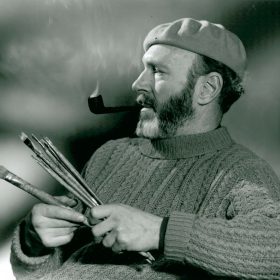Like his father Denis Peploe made some late forest paintings at Rothiemurchus where remnants of the ancient Caledonian forest cover a landscape little changed in a thousand years. He worked on board en plein air for the last time and these small works deliver a powerful, emotional impact.

Denis Peploe was born in 1914, the second son of the celebrated Scottish Colourist S J Peploe. Denis Peploe enrolled at Edinburgh College of Art at the age of seventeen where he was a contemporary of Wilhelmina Barns-Graham and Margaret Mellis. He won post-diploma scholarships to Paris and Florence and took advantage of opportunity to travel extensively in Spain, Italy and Yugoslavia. He first exhibited at The Scottish Gallery in 1947, to critical acclaim. The Glasgow Herald critic responded to the exhibition, saying he was “an artist born fully armed”; and The Bulletin critic wrote: “the general impression of the exhibition is that we have in Denis Peploe a vital and adventurous painter”. Reviewers never avoided mention of his father, and though one couldn’t confuse their work there were similarities in their approaches: each picture was a response to a particular subject, either intellectual or emotional. His son, Gallery Director, Guy Peploe explains:
‘While he was intimately exposed to the mainstream of European art he remained better defined as an artist who responded directly to his subject, en plein air or in the studio. Here the challenge was a live model, or the intellectual exercise of reinvigorating the still life subject. His work remained free of political or art-world references but was at the same time formed by the century of modernism, the times of unprecedented turmoil and change to which he belonged. His response was to cleave to the idea that art was important, even redemptive and that it could somehow describe a better, or more vital place.’
We would be delighted to hear from you if you are considering selling any works by Denis Peploe.